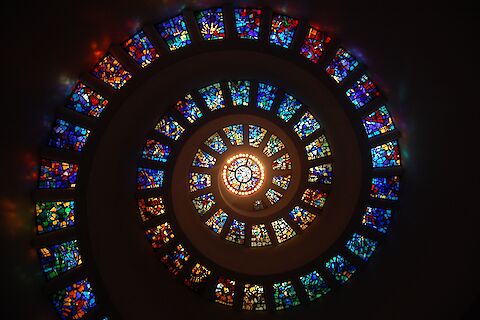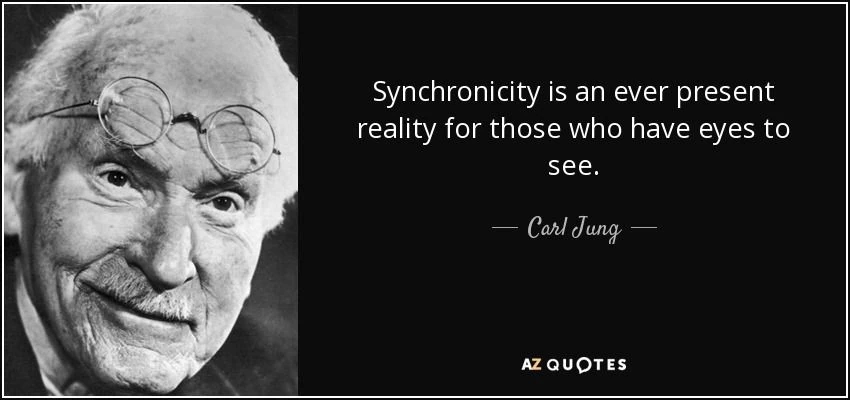

Clustering Illusion or Synchronicity?
The more I have researched the paranormal over the years, the more I realized just how much psychology of the mind plays a significant role. I have already written a whole book about it and I am still only scratching the surface. I am no psychologist of course and don't claim to be, but we know that the human brain is so complex, that Scientists don't even know all there is to know about how and why it works the way it does. While there is a lot about the human mind that we don't know, there are areas that we do know and this is what we need to look at in connection with the way we think about paranormal phenomena. Why? I am not suggesting that experiences are all in our heads because you will know that is not what I believe at all, but I do believe that not everything we experience is paranormal. Sometimes our brain does play tricks on us and it is important to know if what we have experienced is simply a product of our brain or something more. Once you can eliminate these factors, it makes our experiences all the more interesting and significant. We all know that weird stuff happens and that is what a lot of us are looking for.
By us 'looking' for the paranormal, does that make us bias?
A cognitive bias is an error in the way that we think. It means we are not necessarily thinking with a 'clear mind'. Our experiences, our beliefs, and our intentions all influence the way we think, the way we make decisions, and the way we interpret our surroundings. Just the fact that we believe in the paranormal makes us bias. It means we are more prone to 'self-fulfilling prophecy' where our brain is likely to interpret certain things to be paranormal when they are not. We go in looking for the paranormal and our 'brain' makes us find it even if it is not really there. At the other end, a full skeptic is also biased and will tend to look for a rational explanation discounting any sort of ambiguous event without even looking into the possibility it could be something we don't quite understand. No one is immune, however applying critical thinking and taking a moment to really think things through instead of reacting or responding rashly can make a huge difference.
Pareidolia/Apophenia
Our brain is 'wired' to look for patterns. When we look at something, our brain is trying to make sense of it so it interprets it in a way that is familiar to us. It is why when we see clouds, it makes us see the shapes of animals. It is why we see faces in the mist.
This phenomenon is a form of apophenia which is where the brain tries to make sense out of patterns of data. It is thought that this psychological phenomenon was a form of survival that we have inherited from our ancestors.
"As soon as the infant can see, it recognizes faces, and we now know that this skill is hardwired in our brains. Those infants who a million years ago were unable to recognize a face smiled back less, were less likely to win the hearts of their parents, and less likely to prosper."
Carl Sagan
The Demon Haunted World 1995
If a baby did not recognize its parents, it would interact and smile less. It is thought that the brain was 'wired' to recognize the faces to be able to form bonds with its parents. When your child sees your face, it often lights up with a smile, even from those early weeks. The brain was trained to recognize faces. If you want to read more specifically on this topic, check out my article: https://llifs.com.au/blog/pareidolia-matrixing-is-really-just-our-brains-trying-to-be-smart/. It is not just our vision. There is an auditory version as well: https://llifs.com.au/blog/audio-pareidoila-is-a-real-thing/

At first glance, you would be forgiven by thinking that in this photo I took in the corner of this old abandoned lunatic asylum is a young girl with long brown hair in a white gown. Further inspection proved to be markings on the wall that look a certain way in the dark. A perfect example of Pareidolia.
Apophenia is not exclusive to our vision or hearing. It also plays a part in how we interpret the world around us as well. This is known as the Clustering Illusion.
Clustering Illusion
The clustering illusion is almost a way of applying pareidolia to how we interpret data. Our brain looks for a pattern in what is really just something random
A simple way to understand this illusion is to imagine casting ten pennies in a one foot square space. Unless all of the pennies fall in an exactly even distribution, which is extremely improbable, some pennies will be closer to each other than others and seem to form a cluster or group solely from the random distribution.
It's sometimes called the "hot hand fallacy" due to the belief common among basketball coaches and players that it was best to use players on a hot streak (i.e., those who had a "hot hand"). A study demonstrated that the hot hand was a matter of coaches picking a short run of baskets out of a larger sequence that was more or less random.[1] Though there some dispute that the researchers defined "hot hand" (i.e., making exactly 1 basket following another) differently than basketball players actually conceptualize it (in a vaguer sense).
How does this affect the way we think about the paranormal?
The first thing I think about here is the term 'data' that we talked about above. When we think about data and the paranormal, we think about 'evidence'. A lot of what we do as paranormal investigators is collecting 'evidence' or 'data' to try and see if we can find anomalies or patterns that fit with our theory or belief of something being paranormal. A typical example here could be looking at the results of a data logger. There could be random spikes or drops in temperature which really don't mean anything, but because as investigators we have a belief that temperature spikes or drops could indicate a spirit trying to manifest itself, we are automatically going to assume that is what this data set is telling us. Of course, this doesn't mean that the data is trying to tell us something, it just means we have to be mindful when interpreting it - the same way we have to be mindful when we are reviewing audio or looking at photos.
People also use the clustering illusion and apply it to real-life events. A lot of psychics for example that go through different ESP testing may have one particular set where they test significantly higher. Often they will use this as a form of proof of their ability when in reality it could just be a 'lucky streak' based on chance. How you interpret all of this again comes back to what you believe. When we think about something, we start to notice it more and more. For example, if you think about a red car, suddenly you will start to see red cars everywhere. It is because a red car has suddenly become significant to you. ** This falls under the Baader-Meinhof Phenomenon or frequency illusion, something I covered in more detail in my book. While many people recognize this as a form of cognitive bias, others see it as a sign of what is called Synchronicity.
Is it random or is it synchronicity?
This concept of Synchronicity was first brought to the limelight by an analytical psychologist by the name of Carl Jung. The concept was first coined in the 1920s, but it wasn't until the 1950's that he produced a paper "Synchronizität als ein Prinzip akausaler Zusammenhänge" (Synchronicity – An Acausal Connecting Principle) explaining this revelation. The concept is fairly simple and is best described in his own words.
Synchronicity: A meaningful coincidence of two or more events where something other than the probability of chance is involved.
Also described as a 'meaningful coincidence', Jung was a big believer in the paranormal. He felt that if there were two randomly connected events that had no casual relationship but this connection held some sort of significant meaning, he felt something else was at work and called this 'synchronicity'.

I can't tell you if something is paranormal or not. I cannot tell you if an event is random or if it is synchronicity. I can tell you what I believe it is. What I believe it could be is influenced by my own cognitive bias. This is why we all think and interpret everything about the paranormal so differently. While this in some ways can work against us, being aware of it can make it work in our favour. Our different belief systems lead to different thought processes and asking different questions. Some may seem the same but maybe just ever so slightly different. This slight difference could lead us that little bit closer to the answers we are looking for. This is why I also think it is good to listen to what your peers have to say. We each see an experience or a paranormal event differently - even if we were both there witnessing it at the same time. Instead of arguing with each other about what we think it is, let's put it all out on the table and really look at what it could be together. Sometimes I feel like we are fighting with each other to prove our own belief is the right one instead of getting down to the core of the experience of what really happened. We can jump on the paranormal bandwagon sometimes off the bat, and we can equally jump on the rational bandwagon too and not give something the attention it deserves because we are too quick to dismiss it. It starts by listening to someone, not just waiting for your turn to speak.
No matter which side of the fence your bias sits, before jumping to any sort of conclusion, step back and really think about what is happening. Try to put aside what you 'think' it is and try to find out what it really is. Be prepared to be wrong. Be prepared to be right. Be prepared to be none the wiser. This is the beauty of paranormal research. It will frustrate you to the core and you will feel you walk out with more questions than answers, but try to find the real answers, not just what you believe the answers to be. It could flip your whole world upside down and change the way you think about everything! It is uncomfortable, it is confronting and it is what being a true paranormal investigator is all about.
References
The Demon Haunted World Carl Sagan (1995)
https://rationalwiki.org/wiki/Clustering_illusion
Stuff Paranormal Investigators Need To Know Sarah Chumacero (2019)
https://psychology.wikia.org/wiki/Clustering_illusion
If you enjoy LLIFS, consider buying me a book (otherwise known as buy me a coffee but I don't drink coffee and I LOVE books). Your donation helps to fund the LLIFS website so everyone can continue to access great paranormal content and resources for FREE!

Top pages with similar subjects
Don't forget to follow the Facebook page for regular updates
Join the mailing list to receive weekly updates of NEW articles. Never miss an article again!
Buy the latest and past issues Haunted Magazine
Check out the books written by LLIFS